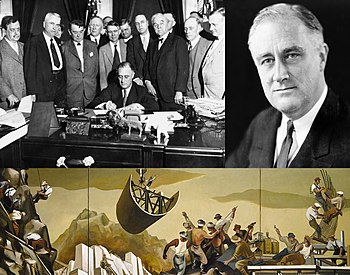New deal

Top left: The Tennessee Valley Authority, part of the New Deal, being signed into law in 1933
Top right: President Roosevelt was responsible for initiatives and programs of the New Deal. Bottom: A public mural from one of the artists employed by the Works Progress Administration, part of the New Deal |
|
| Duration | 1933–1937 |
|---|---|
| Location | United States |
| Type | Economic program |
| Cause | Great Depression |
| Organised by |
|
| Participants | Society of the United States |
| Outcome | Disputed |
The New Deal was a series of programs, including, most notably, Social Security, that were enacted in the United States between 1933 and 1938, and a few that came later. They included both laws passed by Congress as well as presidential executive orders during the first term (1933–37) of President Franklin D. Roosevelt. The programs were in response to the Great Depression, and focused on what historians refer to as the "3 Rs", Relief, Recovery, and Reform: relief for the unemployed and poor, recovery of the economy to normal levels, and reform of the financial system to prevent a repeat depression.
The New Deal produced a political realignment, making the Democratic Party the majority (as well as the party that held the White House for seven out of nine Presidential terms from 1933 to 1969), with its base in liberal ideas, the South, traditional Democrats, big city machines, and the newly empowered labor unions and ethnic minorities. The Republicans were split, with conservatives opposing the entire New Deal as an enemy of business and growth, and liberals accepting some of it and promising to make it more efficient. The realignment crystallized into the New Deal Coalition that dominated most presidential elections into the 1960s, while the opposing conservative coalition largely controlled Congress from 1939 to 1964. By 1936 the term "liberal" typically was used for supporters of the New Deal, and "conservative" for its opponents. From 1934 to 1938, Roosevelt was assisted in his endeavours by a "pro-spender" majority in Congress (drawn from two-party, competitive, non-machine, Progressive, and Left party districts). As noted by Alexander Hicks, "Roosevelt, backed by rare, non-Southern Democrat majorities—270 non-Southern Democrat representatives and 71 non-Southern Democrat senators—spelled Second New Deal reform." In the 1938 midterm elections, however, Roosevelt and his liberal supporters lost control of Congress to the bipartisan conservative coalition.
...
Wikipedia
